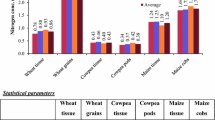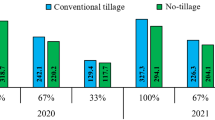Abstract
Enormous quantity of water is used for coal beneficiation and accordingly huge amount of effluents are being generated. In this study an attempt was made to evaluate the potential of this effluent water for irrigation. Water samples were collected from three different points (a) feeding point, (b) thickening point, and (c) outlet point of coal washery, and from Damodar River for monitoring the water quality. The samples were analyzed for various parameters and compared with prescribed standard, which revealed that the total suspended solids of thickening point and Damodar River were higher. A pot experiment with maize was conducted to study the suitability of this coal washery water for irrigation. Pots were irrigated with water from the three points of washery and Damodar River in two concentrations (100% and 50% dilution with distilled water); pure distilled water was used for control. There was 100% germination in all the treatments. The plant growth, chlorophyll content and soil quality parameters were significantly better in washery and Damodar River water treated pots. The Damodar River water and washery water from feeding and outlet point could be successfully used for irrigation. In general mixing with good quality water has shown better results.
Similar content being viewed by others
References
APHA (1985). Standard methods for examination of water and wastewater. Washington, DC: American Public Health Association.
Arnon, D. I. (1949). Copper enzymes in isolated chloroplasts. polyphenoloxidase in Beta vulgaris. Plant Physiology, 24, 1–15.
Arora, V., Jha, U., Bandhopadhyay, P., & Kumar, S. (2006). An investigation of the relationship between raw coal characteristics and effluent quality of Kedla and Rajrappa Washeries, Jharkhand, India. Journal of Environmental Management, 78, 392–404.
Aziz, O., Inam, A., & Siddiqi, R. H. (1994). Impact of treated oil refinery effluent on crop productivity and agricultural soils. Indian Journal of Environmental Health, 36, 91.
Bandopadhyay, P. (1995). Impact and abatement of pollution in coal and mineral processing. Dhanbad: Workshop of Mining Environment, ENVIS Center, CME, ISM.
Barnett, J. W., Kerridge, G. J., & Russell, J. M. (1994). Effluent treatment systems for dairy industry. Australian Biotechnology, 4, 26–30.
Chakraborti, T. (1994). Management of toxic liquid wastes using biotechnological routes, Symposium Environmental Biotechnology, 28–29 March NEERI, Nagpur, pp II 6–1.
Chhonkar, P. K., Bhadraray, S., Patra, A. K., & Purakayastha, T. J. (2007). Experiments in soil biology and biochemistry p. 182. New Delhi: Westville Publishing House 110 063.
Chonnkar, P. K., Datta, S. P., Joshi, H. C., & Pathak, H. (2000). Impact of industrial effluents on soil health and agriculture – Indian experience. Part I: distillery and paper mill effluents. Journal of Scientific and Industrial Research, 59, 350–361.
Claudio, L., Riccardo, G., Francesco, P. N., & Francesco, F. (2004). Municipal-treated wastewater reuse for plant nurseries irrigation. Water Research, 38(Issue 12), 2939–2947.
CWC (2000). Water and related statistics. RK Puram, New Delhi: Information Systems Organization, Water Planning and Organization Wing, Central Water Commission 66, 451.
Dighton, J., & Jones, H. E. (1991). The use of roots to test N, P and K deficiency in Eucalyptus nutrition. IUFRO Symposium on Intensive Forestry: The Role of Eucalyptus. (pp. 635–643). Durban, South Africa.
Ghose, M. K. (1999). Sustainable supplies of water for coal washeries in India. The Science of the Total Environment, 229, 217–225.
IS. (1974). Indian Standards for Industrial Effluents. IS: 2490.
Kaushik, A., Kadyan, B. R., & Kaushik, C. P. (1996). Sugar mill effluent effects on growth, photosynthetic pigments and nutrient uptake in wheat seedlings in aqueous vs. soil medium. Water Air & Soil Pollution, 87, 39–46.
Khoury, D. L. (1981). Coal cleaning technology. New Tessey, USA: Park Ridge.
Masto, R. E., Chhonkar, P. K., Singh, D., & Patra, A. K. (2006). Changes in soil biological and biochemical characteristics in a long-term field trial on a sub-tropical inceptisol. Soil Biology and Biochemistry, 38, 1577–1582.
Mitchell, R. (1956). Coal preparation. New York.
Orhan, Ed Kural, Coal, Resources, Properties, Utilization, Pollution (pp.115–125).
Narwal, R. P., Singh, A., & Dahiya, S. S. (2006). Effect of paper mill effluent's irrigation on soil and plants health – a case study. The 18th World Congress of Soil Science, Philadelphia, USA.
Rattan, R. K., Datta, S. P., Chhonkar, P. K., Suribabu, K., & Singh, A. K. (2005). Long-term impact of irrigation with sewage effluents on heavy metal content in soils, crops and groundwater – a case study. Agriculture Ecosystems and Environment, 109, 310–322.
Raverkar, K. P., Ramana, S., Singh, A. B., Biswas, A. K., & Kundu, S. (2000). Impact of post-methanation spentwash (PMS) application on the nursery raising, biochemical parameters of Gliricidia sepium and biological activity of soil. Annuals of Plant and Soil Research, 2, 161–168.
Siddiqi, R. H., Samiullah, Inam, A., Khan, N. A., & Aziz, O. (1994). Plant productivity under environmental stress. Agro Botanical Publishers India, Bikaner, p. 367.
Singh, A. K. (2003). Water resources and their availability. In: Souvenir, National Symposium on Emerging Trends in Agricultural Physics, Indian Society of Agrophysics, New Delhi, 22– 4 April 2003, pp. 18–29.
Swaine, D. J. (1990). Trace elements in coal. London: Butterworth (Chapter 9).
Tandon, H. L. S. (1995). Methods of analysis of soils, plants, water and fertilizers. New Delhi: Fertilizer Development and Consultation Organisation.
Tiwary, R. K., & Dhar, B. B. (1994). Environmental pollution from coal mining activities in Damodar river basin, India, Mine water and the environment, Vol. 13. June–December pp 1–10.
Vlado, V. (1983). Trace elements in coal, vol. 1. Boca Raton, FL: CRC Press.
Author information
Authors and Affiliations
Corresponding author
Rights and permissions
About this article
Cite this article
Selvi, V.A., Prajapati, N., Masto, R.E. et al. Environmental impact of coal washery and Damodar River water on the morphometry and biochemical changes of maize (Zea mays L.) and soil health. Environ Monit Assess 145, 251–256 (2008). https://doi.org/10.1007/s10661-007-0034-3
Received:
Accepted:
Published:
Issue Date:
DOI: https://doi.org/10.1007/s10661-007-0034-3




